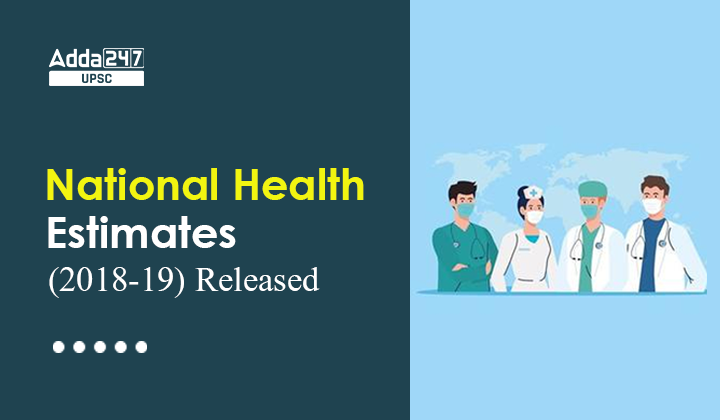Table of Contents
National Health Accounts (NHA) Estimates- Relevance for UPSC Exam
- GS Paper 2: Governance, Administration and Challenges
- Government policies and interventions for development in various sectors and issues arising out of their design and implementation.
National Health Accounts (NHA) Estimates in News
- Recently, NITI Aayog, in presence of Shri Rajesh Bhushan, Secretary, Union Ministry of Health & Family Welfare released findings of the National Health Accounts (NHA) Estimates for India for 2018-19.
NHA Estimates on Health Expenditure
- The Union government’s healthcare spend dropped to 1.28% of the Gross Domestic Product (GDP) in 2018-19 from the previous year’s figure of 1.35%.
- The NHA estimates for 2018-19 show that there has been an increase in the share of government health expenditure in the total GDP of the country.
- It has increased from 1.15% in 2013-14 to 1.28% in 2018-19.
- Additionally, the share of Government Health Expenditure in Total Health Expenditure has also increased over time.
- In 2018-19, the share of government expenditure was 40.6%, substantially higher than the share of 28.6% in 2013-14.
- NHA findings also indicate that Government’s health expenditure as a percentage of Current Health Expenditure has increased from 23.2% in 2013-14 to 34.5% in 2018-19.
- It has also been observed that per capita government spending on healthcare has increased by 74% since 2013-14, i.e., Rs. 1042 to Rs. 1815 in 2018-19.
- Primary and secondary care accounts for more than 80% of the current Government Health Expenditure.
- Between 2013-14 and 2018-19, in government, the share of primary and secondary care has increased from 74% to 86%.
- In case of the private sector, the share of tertiary care has increased but primary and secondary care show a declining trend.
- In the private sector, the share of primary and secondary care has declined from 82% to 70% during the same period.
NHA Estimates on Out-Of-Pocket Expenditure (OOPE)
- Out-of-Pocket Expenditure (OOPE) as percentage of total health expenditure has declined substantially by 16% points, from 64.2% to 48.2%.
- Out of pocket expenditure as a percentage of current health expenditure has also declined over time from 69.1% in 2013-14 to 53.2% in 2018-19.
- Per capita out-of-pocket expenditure in the country has decreased by 8% since 2013-14, from Rs. 2,366 to Rs. 2,155 currently.
NHA Estimates 2018-19 Findings on Other Indicators
- Focusing on social security has resulted in expenditure on health as a percentage of total health expenditure growing from 6% to 9.6% now.
- The NHA also reveals that the government-financed health insurance expenditure has increased by 167% since 2013-14.
NHA Estimates- Trends in the Health Sector
| Indicators | 2017-18
(in Rs Crores) |
2018-19
(in Rs Crores) |
Percentage change |
| Gross Domestic Product (GDP) | 1,70,90,042 | 1,88,99,668 | 11% |
| General Government Expenditure (GGE) | 45,15,946 | 50,40,707 | 12% |
| Total Health Expenditure (THE) | 5,66,644 | 5,96,440 | 5% |
| Government Health Expenditure (GHE) | 2,31,104 | 2,42,219 | 5% |
National Health Account (NHA) Estimates
- About: The National Health Account (NHA) estimates for India 2018-19 is the sixth consecutive NHA estimates report prepared by NHSRC.
- NHSRC designated as National Health Accounts Technical Secretariat (NHATS) in 2014 by the Union Health Ministry.
- Preparation: The NHA estimates are prepared by using an accounting framework based on the internationally accepted standard of System of Health Accounts, 2011, developed by the World Health Organization (WHO).
- Significance: With the present estimate of NHA, India now has a continuous series of NHA estimates for the country, from 2013-14 to 2018-19.
- These estimates are not only comparable internationally, but also enable the policymakers to monitor the progress in different health financing indicators of the country.
National Family Health Survey: Population Slowdown




 TSPSC Group 1 Question Paper 2024, Downl...
TSPSC Group 1 Question Paper 2024, Downl...
 TSPSC Group 1 Answer key 2024 Out, Downl...
TSPSC Group 1 Answer key 2024 Out, Downl...
 UPSC Prelims 2024 Question Paper, Downlo...
UPSC Prelims 2024 Question Paper, Downlo...





